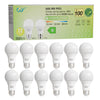
The Truth About LED Bulb Ratings: Are Class A & B Worth Your Money?
The Truth About LED Bulb Ratings: Are Class A & B Worth Your Money?
You’re standing in the lighting aisle, holding two boxes. In one hand, a pack of standard GU10 LEDs for a bargain-basement price. In the other, a Class A rated bulb with a slightly higher price tag. Your wallet is whispering, "Go cheap," but your gut is wondering, "What am I really getting here?"
We’ve all been there. It’s tempting to save a few euros upfront. But what if that initial "savings" ends up costing you more in the long run?
The truth is, not all LED bulbs are created equal. The EU Energy Label, with its simple A-to-G scale, is like a bulb's report card, and Class A and B are the honor students. They’re not just a little better; they represent a fundamental leap in efficiency and quality. So, let's cut through the marketing and break down whether that higher initial investment is truly worth it. Spoiler alert: the answer almost always leans toward a resounding "yes," and here’s the real-world math behind why.
The Upfront Sticker Shock vs. Long-Term Wallet Relief
Let’s talk about the most immediate concern: the price. A Class B or Class A LED bulb will cost more at the checkout counter. There’s no denying it. But a light bulb isn’t a one-time purchase; it’s a long-term relationship. The real cost isn't the price on the box; it's the total cost of ownership.
Think of it like buying a car. You could buy a cheap, unreliable car that guzzles fuel. Or, you could invest in a fuel-efficient, reliable model that costs more upfront but saves you a fortune on gas and repairs for years. Class A and B LEDs are the fuel-efficient cars of the lighting world.
They achieve this through superior luminous efficacy—that is, more light (lumens) per watt of electricity consumed. While a cheap bulb might struggle to be efficient, a Class A bulb is a master of converting energy into beautiful, usable light. This means that for the same amount of brightness, a high-efficiency LED from our collection will sip energy while a cheaper, lower-class bulb will guzzle it. Over the course of a year, and especially over the bulb's entire lifespan, those small savings on your electricity bill add up to a significant sum, often completely offsetting that higher initial price.
The Hidden Cost of "Bargain" Bulbs: Lifespan and Flicker
Here’s a scenario we’ve all faced: the bulb in the high-ceiling hallway or the integrated kitchen downlighter burns out. You sigh, get the ladder, and perform the awkward, arm-straining ritual of replacement. Now, imagine doing that half as often.
This is where Class A and B LEDs shine. While a standard LED might promise a decent 10,000 hours, a long-lasting Class A LED can deliver 30,000 hours or more. Let's do the math: if you have a light on for 8 hours a day, a 30,000-hour bulb will last for over 10 years. That’s a decade of not thinking about that bulb. The savings in time, hassle, and replacement costs are immense.
Then there's performance. Have you ever noticed a cheap bulb has a subtle, annoying flicker, or that its bright white light slowly turns into a murky yellow over time? This is a hallmark of poor-quality components and inadequate heat management. Class A and B LEDs are engineered with better materials and effective heat sinks that dissipate warmth, protecting the delicate internal components. The result? Consistent, flicker-free light and stable color temperature from the day you install it until the day you finally replace it years later. Your eyes and your mood will thank you.
More Than Money: The Environmental Choice
For many of us, our purchasing decisions are increasingly guided by their environmental impact. This is another area where higher-rated LEDs excel. Their superior energy efficiency means less demand on power plants and lower carbon emissions. Their extended lifespan means fewer bulbs in the landfill. Choosing a Class A bulb isn’t just a smart financial decision; it’s a simple, tangible step toward a more sustainable household. You reduce your carbon footprint literally with the flip of a switch.
The Verdict: An Investment in Light
So, are Class A and B LED bulbs worth the extra cost? When you look beyond the initial price tag and consider the whole picture—the dramatic reduction in energy bills, the years of hassle-free operation, the superior light quality, and the positive environmental impact—the answer becomes clear.
You’re not just buying a bulb; you’re making a savvy investment. You’re investing in a product that costs less to operate, doesn’t need to be constantly replaced, and makes your home a more comfortable and sustainable place.
Ready to make the switch to lighting that saves you more? Explore our range of high-performance, Class A rated GU10 LED bulbs and experience the difference for yourself. For a full smart home upgrade, consider pairing them with our intelligente Smart LED lampen for complete control over your home's ambiance.












